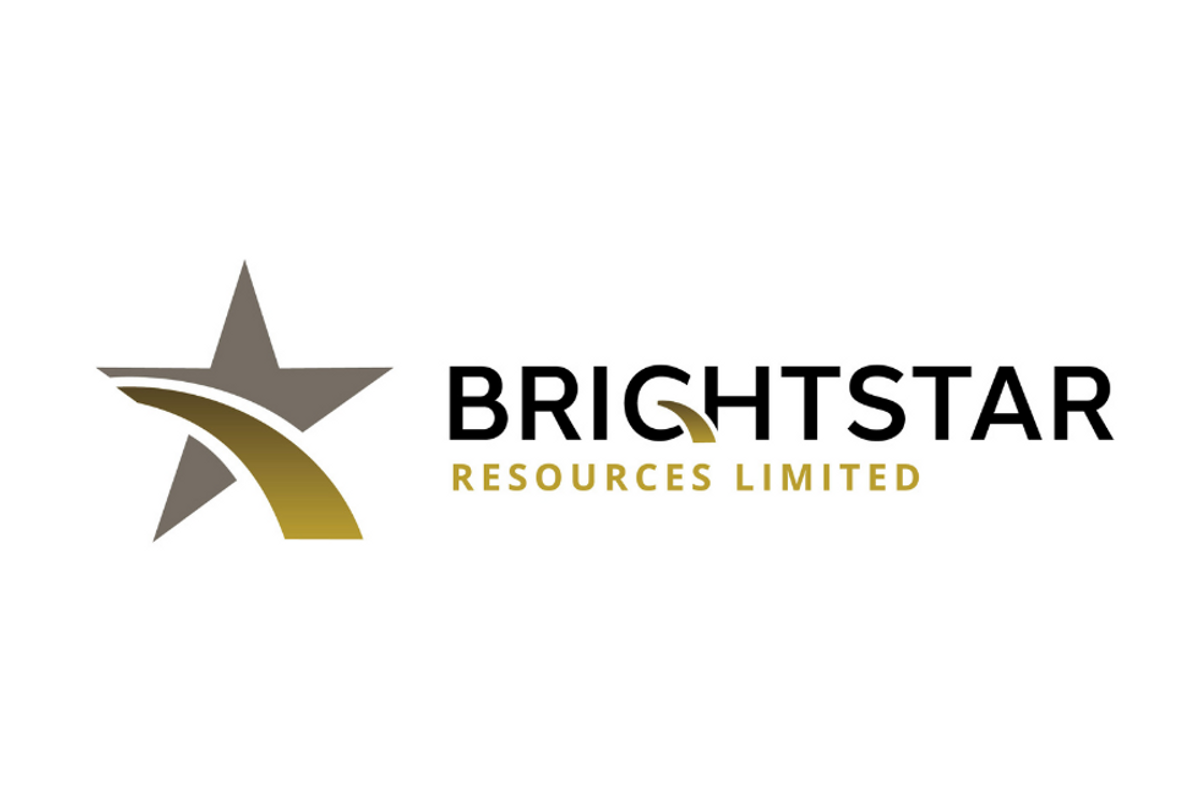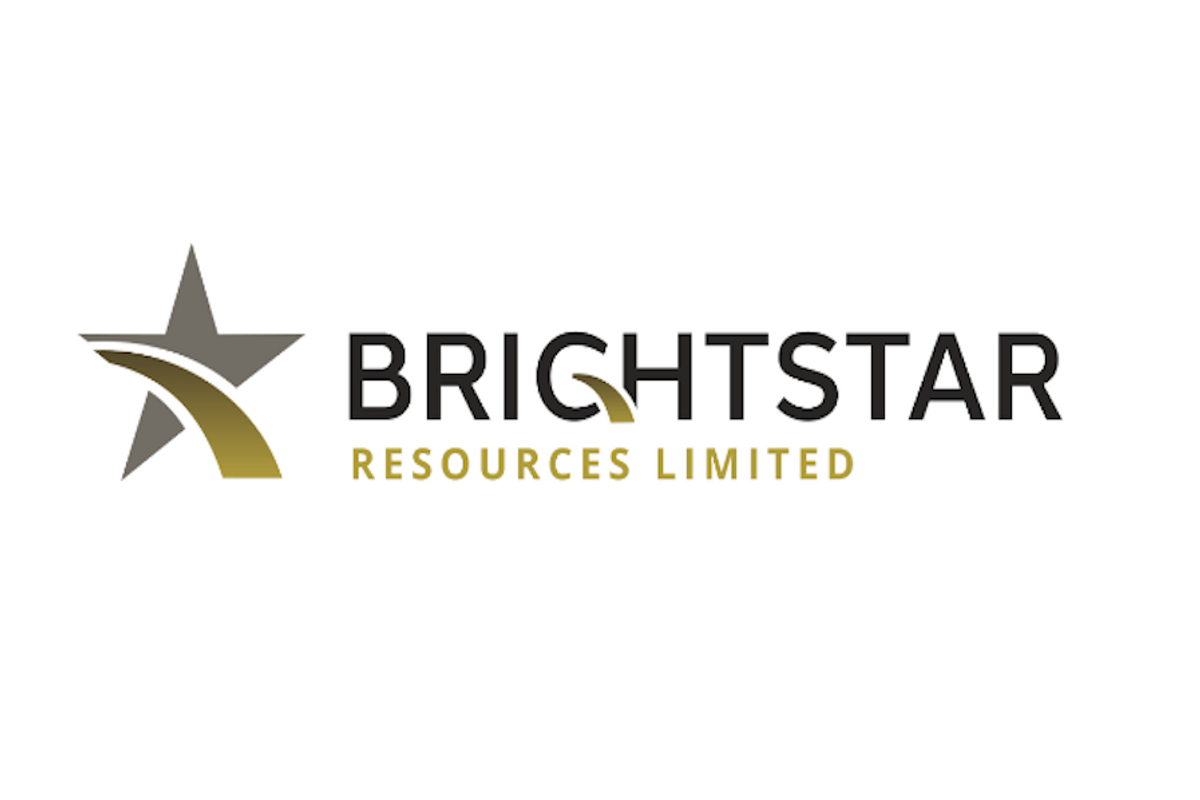
July 31, 2024
The securities of Brightstar Resources Limited (ASX: BTR) will be placed in trading halt at the request of BTR, pending it releasing an announcement. Unless ASX decides otherwise, the securities will remain in trading halt until the earlier of the commencement of normal trading on Friday, 2 August 2024 or when the announcement is released to the market.
Issued by
ASX Compliance
Click here for the full ASX Release
This article includes content from Brightstar Resources, licensed for the purpose of publishing on Investing News Australia. This article does not constitute financial product advice. It is your responsibility to perform proper due diligence before acting upon any information provided here. Please refer to our full disclaimer here.
BTR:AU

Sign up to get your FREE
Brightstar Resources Investor Kit
and hear about exciting investment opportunities.
- Corporate info
- Insights
- Growth strategies
- Upcoming projects
GET YOUR FREE INVESTOR KIT
The Conversation (0)
19 June
Brightstar Resources
Investor Insight
With multiple catalysts ahead, including resource upgrades, expanded production, and further development of its Laverton, Menzies, and Sandstone hubs, Brightstar Resources presents a compelling investment case in a rising gold market.
Overview
Gold has continued to demonstrate its resilience as a store of value, with prices peaking at US$3,500.05 per ounce, its all-time high. Amid ongoing global economic uncertainty, including inflationary pressures, rising geopolitical tensions, and volatile interest rate environments, investors have turned to gold as both a safe haven asset and a hedge against macroeconomic instability.
Brightstar Resources (ASX:BTR) is strategically positioned to capitalize on this environment as a low-cost, multi-asset gold developer with near-term production potential. The company controls over 1,500 square kilometers of highly prospective ground across three of Western Australia’s most prolific gold belts: the Laverton Tectonic Zone, the Menzies Shear Zone, and the Sandstone Greenstone Belt.
Unlike many junior exploration companies, Brightstar has a key differentiator: it owns a fully permitted, strategically located processing facility near Laverton. This existing infrastructure offers the company a critical advantage, enabling a low-capex restart scenario and faster time to cash flow compared to peers who must first secure permits and fund costly plant construction. This plant is subject of a DFS due for announcement in June 2025.
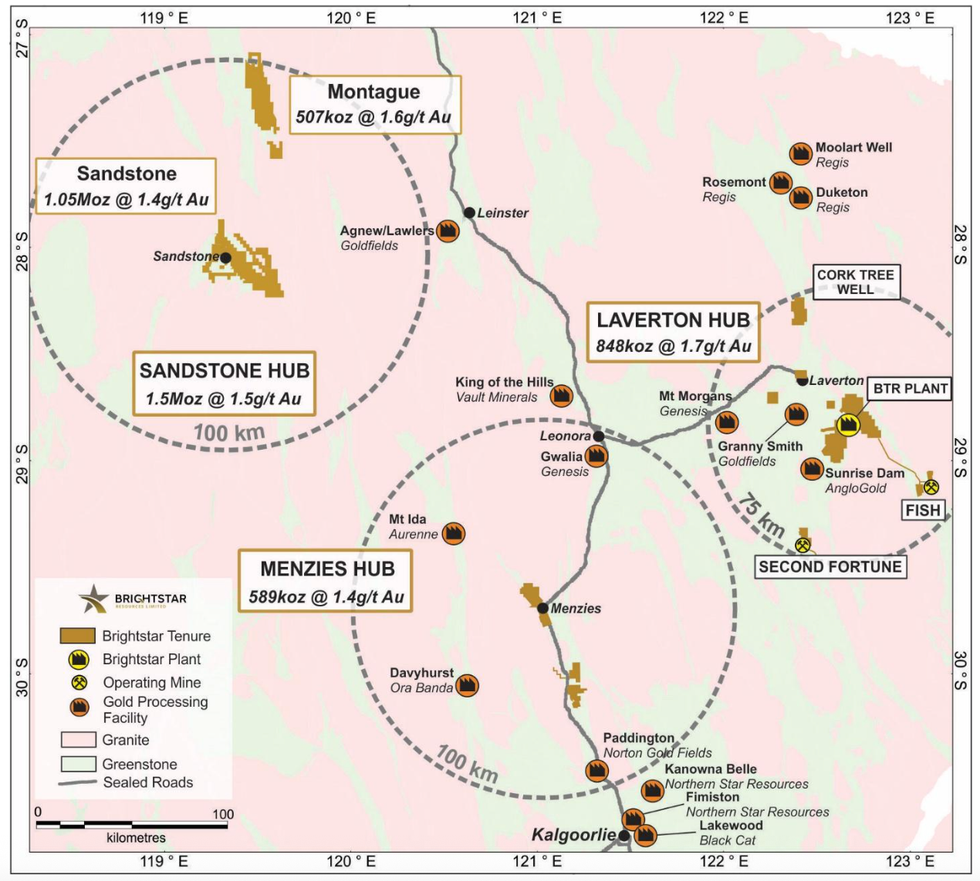
Through a focused multi-hub strategy, Brightstar has built a robust pipeline of development-ready and resource-growth projects, supported by:
- Over 3 million ounces of gold resources across Laverton, Menzies, and Sandstone;
- Ongoing high-grade drilling success in 2024 and 2025, including intercepts of up to 10m @ 43.8 g/t gold;
- A track record of low-cost, value-accretive acquisitions, such as Linden Gold Alliance and Alto Metals;
- A dedicated, in-house technical team executing on aggressive exploration, fast-tracked studies, and staged development.
With global gold demand remaining strong, Brightstar is well-positioned to deliver material shareholder value through its integrated production plan, supported by scalable infrastructure, a growing resource base, and access to capital. The company’s strategic approach includes combining brownfields development, organic exploration, and corporate M&A, placing it at the forefront of a new generation of Australian gold producers.
Company Highlights
- ASX-listed gold exploration and development company with a consolidated mineral endowment of 3 Moz of gold across Laverton, Menzies, and Sandstone hubs in Western Australia.
- Owns and operates 100 percent of project areas: 300 sq km in Laverton Tectonic Zone, 80 sq km in Menzies Shear Zone, and 1,200 sq km in Sandstone Greenstone Belt.
- Gold processing operations at the Laverton facility have commenced under an Ore Purchase Agreement (OPA) with Genesis Minerals Ltd (ASX:GMD), marking a significant milestone in transitioning from exploration to production.
- Recent drilling campaigns have yielded strong high-grade results, including:
- 16m @ 8.0 g/t gold at Second Fortune (Laverton)
- 10m @ 43.8 g/t gold at Musketeer (Sandstone)
- 16m @ 8.0 g/t gold at Yunndaga (Menzies)
- Following the successful Linden Gold Alliance acquisition, Brightstar has commenced a DFS for the wider development of its Laverton and Menzies assets which is due for release imminently in June 2025.
- Ongoing Sandstone drilling continues to return high-grade intercepts, further supporting project advancement and MRE conversion.
- In 2024, Brightstar signed a $4 million drill-for-equity deal with Topdrill to fast-track exploration at Sandstone.
- The company has successfully executed a US$11.5 million (AU$18 million) revolving stockpile finance facility with Ocean Partners Australia.
Key Projects

Laverton Hub
Brightstar’s Laverton hub is comprised of the Cork Tree Well, Jasper Hills, Second Fortune, Beta and Alpha project areas.
Highlights:
- Combined, the Laverton Hub JORC mineral resource estimate is 15.7 Mt @ 1.7 g/t gold for 848 koz (49 percent measured and indicated category). All mineral resources are on granted mining leases
- Cork Tree Well (6.4 Mt at 1.4 g/t gold for 292 koz gold)
- Alpha (1.4 Mt at 2.3 g/t gold for 106 koz gold)
- Beta (1.9 Mt at 1.7 g/t gold for 102 koz gold)
- Lord Byron (5.2 Mt at 1.5 g/t gold for 251 koz gold)
- Fish (376 kt at 4.0 g/t gold for 49 koz gold)
- Second Fortune (92 kt at 13.4 g/t gold for 40 koz gold)
- Gilt Key (168 kt at 1.3 g/t gold for 8 koz gold)
- Main project area Cork Tree Well is open at depth and along strike with recent drilling results of 34.4 meters at 7.94 g/t gold from 43.5 meters (CTWMET004) and 27.6 meters at 17.8 g/t gold from 51 m (CTWMET003)
- Second Fortune has a mineral resource estimate head grade of ~11g/t gold with an average ore body width of 0.6 meters.
- Jasper Hills is located 50 km from Brightstar’s existing processing facility along a wholly-owned private haul road, allowing unimpeded, direct access to both projects
- Permitted, previously mined and production-ready
- Last mined by current owners in 2020 with 23,000 oz gold mined
- Growth Drivers:
- Second Fortune: Consistent, stable production and cash generation through 2025
- Fish: Mining activities have commenced and site establishment is continuing.
- First ore production targeted in June
- Open pits development: Large scale production opportunities through mining Lord Byron and Cork Tree Well as multi-year base load ore sources
- DFS: due for delivery in June 2025, including design and costs for expansion of BTR-owned processing infrastructure to 1Mtpa.
Menzies Hub
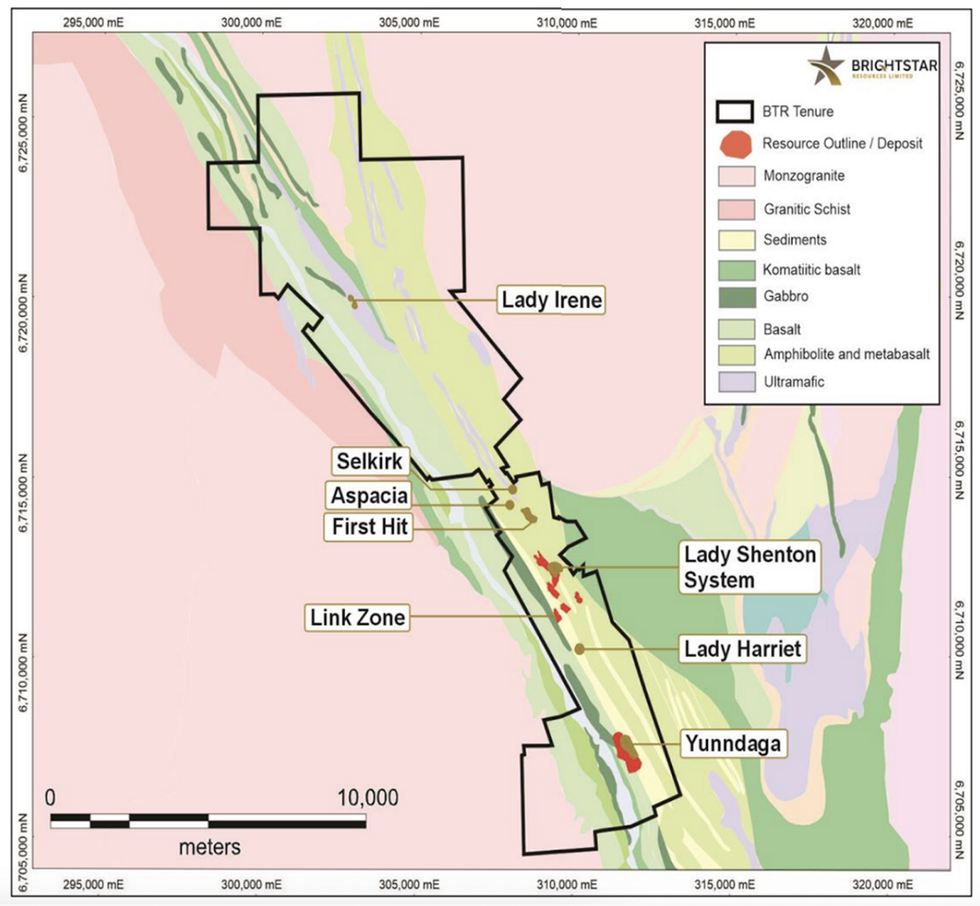
The Menzies Hub comprises a tenement holding of a contiguous land package of granted mining leases over a strike length of more than 20 km. The majority of deposits hosted along the Menzies Shear Zone are located adjacent to the Goldfields Highway in Menzies (130km north of Kalgoorlie).
Highlights:
- Total Current Resource: 12.7 Mt at 1.4 g/t gold for 589 koz gold (37 percent measured and indicated)
- DFS: due for delivery in June 2025, including design and costs for open pit and underground mining for toll processing/ore sales to a regional Kalgoorlie-Menzies mill.
- Growth Drivers:
- Lady Shenton Open Pit: Proposed multi-year consistent open pit production to provide cash generation. Targeting approvals received and ‘mine ready’ in 2025
- Yunndaga Underground: Planned infill drilling targeting conversion of Inferred Mineral Resources to M+I to support inclusion in future mining operations – recent results from this program include 16m @ 8.0 g/t gold
- Development: Advancing discussions with regional mills for 3rd party processing capacity in the Kalgoorlie-Menzies region, targeting a mining decision.
Sandstone Hub
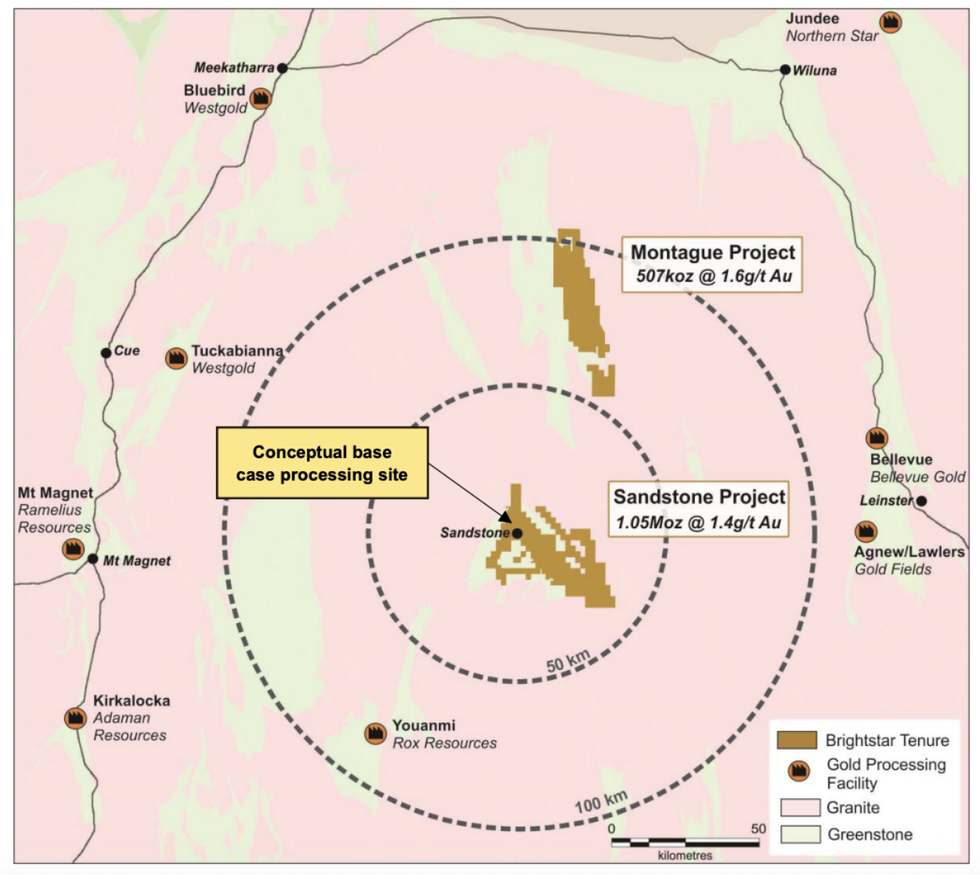
The consolidated Sandstone project is over 100 km from existing third-party milling operations in the Murchison. This third processing hub boasts Alto’s Sandstone project with a mineral resource of 1.05 Moz at 1.4 g/t gold and Gateway’s Montague gold project with a mineral resource of 0.5 Moz @ 1.6 g/t gold.
Growth Drivers:
- Sandstone: Upgrade the Lords, Vanguard, Indomitable and Havilah camps to Indicated classification (40,000m RC+DD)
- Montague: Infill Montague and Whistler to Indicated classification (5,000m RC and 1,200m DD) – RC
- Greenfields: Follow up drilling of priority prospects across Sandstone Hub (West Hacks, Hancocks, Bulchina, Lords Corridor, Duplex) – recent drilling success includes exceptional intercepts at the Musketeer prospect yielding 10m @ 43.8 g/t gold
- Pre-Feasibility Study: Incorporation of 2025 drilling results into MRE upgrades to then factor into 1H 2026 Sandstone PFS
Management Team
Alex Rovira - Managing Director
Alex Rovira is a qualified geologist and an experienced investment banker having focused on the metals and mining sector since 2013. Rovira has experience in ASX equity capital markets activities, including capital raisings, IPOs and merger and acquisitions.
Richard Crookes - Non-executive Chairman
Richard Crookes has over 35 years’ experience in the resources and investments industries. He is a geologist by training having previously worked as the chief geologist and mining manager of Ernest Henry Mining in Australia.
Crookes is managing partner of Lionhead Resources, a critical minerals investment fund and formerly an investment director at EMR Capital. Prior to that he was an executive director in Macquarie Bank’s Metals Energy Capital (MEC) division where he managed all aspects of the bank’s principal investments in mining and metals companies.
Andrew Rich - Executive Director
Andrew Rich is a degree qualified mining engineer from the WA School of Mines and has obtained a WA First Class Mine Managers Certificate. Rich has a strong background in underground gold mining with experience predominantly in the development of underground mines at Ramelius Resources (ASX:RMS) and Westgold Resources (ASX:WGX).
Ashley Fraser - Non-executive Director
Ashley Fraser is an accomplished mining professional with over 30 years experience across gold and bulk commodities. Fraser was a founder of Orionstone (which merged with Emeco in a $660-million consolidation) and is a founder/owner of Blue Cap Mining and Blue Cap Equities.
Jonathan Downes - Non-executive Director
Jonathan Downes has over 30 years’ experience in the minerals industry and has worked in various geological and corporate capacities. Experienced with gold and base metals, he has been intimately involved with the exploration process through to production. Downes is currently the managing director of Kaiser Reef, a high grade gold producer, and non-executive director of Cazaly Resources.
Dean Vallve – Chief Development Officer
Dean Vallve holds technical qualifications in geology & mining engineering from the WA School of Mines, an MBA, and a WA First Class Mine Managers Certificate. Vallve was previously in senior mining and study roles at ASX listed mid-cap resources companies Hot Chili (ASX:HCH) and Calidus Resources (ASX:CAI).
Nicky Martin – Chief Financial Officer
Nicky Martin is an experienced finance and accounting professional holding tertiary qualifications in accounting and finance and is a qualified CPA. Martin was previously the Head of Finance at Pilbara Minerals Ltd (ASX:PLS) where she oversaw and was actively involved in a rapidly growing mining success story.
Keep reading...Show less
Emerging gold producer and district-scale resource developer in Western Australia
20h
High grade gold in early stage drilling at Sandstone
30 June
Merger Discussions Between Brightstar and Aurumin
29 June
Menzies and Laverton Gold Projects Feasibility Study
5h
Sun Summit Minerals: Advancing District-scale Gold and Copper Projects in British Columbia
Sun Summit Minerals (TSXV:SMN,OTCQB:SMREF) is a Canadian mineral exploration company advancing district-scale gold and copper projects in British Columbia. Its flagship JD Project, located in the prolific Toodoggone district, is the focus of an aggressive 5,000-meter drill program in 2025 targeting a potential multi-million-ounce epithermal gold-silver system.
With funding in place, a five-year exploration permit secured, and an on-site camp established, Sun Summit is executing a disciplined strategy to build scale, unlock resource value, and deliver returns to shareholders. Reinvigorated by a revamped leadership team and a refined vision, the company is leveraging high-grade, strategically located assets to drive long-term growth.

The JD and Theory projects cover over 25,000 hectares in the heart of British Columbia’s Toodoggone mining district, one of Canada’s most prospective regions for epithermal gold-silver and porphyry copper-gold systems. The district hosts several significant deposits, including Thesis Gold’s Ranch and Lawyers projects (4.7 Moz gold equivalent, ~C$250 million market cap), Centerra Gold’s Kemess underground development, and TDG Gold’s Shasta-Baker project. The area is well supported by infrastructure, including hydroelectric grid access, all-season roads, and the nearby Sturdee airstrip.
Company Highlights
- Aggressive Discovery Strategy: Sun Summit Minerals is actively advancing the JD and Buck projects in BC, targeting epithermal gold-silver and porphyry copper-gold systems. A fully funded 5,000-meter drill program at JD underway in 2025, aiming to define a multi-million-ounce resource.
- Strategic Location: Both assets are situated in prolific and mining-friendly regions of British Columbia. The flagship JD project lies in the Toodoggone district—home to Thesis Gold and Centerra’s Kemess Mine, while Buck is near the Blackwater, Huckleberry, and Equity Silver mines in central BC.
- Re-rate Potential Opportunity: Trading at just ~$7/oz gold equivalent (EV/oz) based on Buck alone, with no value currently ascribed to JD, the company represents a deep value opportunity compared to the next-door neighbour Thesis Gold trading at ~$50/oz. Success at the drill bit from the ongoing drill program at JD could drive the potential re-rating.
- Fully Funded for 2025: A recent C$10M raise (May 2025) enables a robust exploration program, including drilling, geophysics, and soil sampling. The company is well-positioned to achieve its 2025 and 2026 exploration milestones without further dilution.
- Experienced, Capital Markets-Savvy Leadership: CEO Niel Marotta brings capital markets acumen from Fidelity and Orezone. The broader team includes senior geologists and advisors with decades of success in gold discoveries and mine development in BC.
- Positioned for Consolidation: With majors like Freeport, Centerra, and Skeena investing heavily in adjacent properties, Sun Summit is strategically located and advancing at the right time in the Lassonde Curve to benefit from industry-wide M&A and consolidation trends.
This Sun Summit Minerals profile is part of a paid investor education campaign.*
Click here to connect with Sun Summit Minerals (TSXV:SMN) to receive an Investor Presentation
Keep reading...Show less
22h
David Erfle: Silver Staging "Powerful" Breakout; Plus Gold Stocks and Copper Squeeze
David Erfle, editor and founder of Junior Miner Junky, shares his short-term outlook for gold, saying it could see a healthy test of US$3,200 per ounce — or even US$2,950 to US$3,000.
Erfle also shares his thoughts on what's coming for silver and copper prices.
Don't forget to follow us @INN_Resource for real-time updates!
Securities Disclosure: I, Charlotte McLeod, hold no direct investment interest in any company mentioned in this article.
Keep reading...Show less
22h
Meeka Metals Reports First Gold Pour at Murchison Project
Meeka Metals (ASX:MEK) has poured the first gold at its flagship Murchison project in Western Australia.
The pour happened on Tuesday (July 1), and in a Wednesday (July 2) press release, the company said the project’s production is in line with schedule, happening within 12 months of breaking ground.
Murchison sits near several multimillion-ounce gold mines and hosts a large, high-grade resource of 1.2 million ounces at 3 grams per tonne (g/t) gold on granted mining leases.
Meeka released a definitive feasibility study in December 2024, outlining a 10 year production plan for the project. Up to 76,000 ounces per annum are targeted, with an average of 65,000 ounces approximated for the first seven years.
The study also focused on restarting the Andy Well mill, with site activity commencing during Q1 2025. Process plant commissioning followed in the next quarter, with the first gold pour following its projected schedule of mid 2025.
“It is an impressive achievement by the team to deliver first gold on time and within 12 months of breaking ground at the Murchison,” said Managing Director Tim Davidson. “We are now focused on ramping up gold production toward our targeted 80 kilo ounces per annum with the arrival of the third dig fleet and expanded open pit mining plan underway.”
Drilling at Turnberry Central, part of Murchison, was announced on June 10. Results include 30 metres at 1.09 g/t gold from 29 meters, including 9 meters at 2.45 g/t gold.
The company announced in mid-June that process plant commissioning was underway at Murchison.
Underground mining at Murchison’s Andy Well mill is set to begin in the third quarter of 2025. As per a company presentation shared by Meeka on June 19, Andy Well hosts a mineral resource of 505,000 ounces at 8.6 g/t gold.
First ore from Andy Well is expected in the third quarter of this year.
Don’t forget to follow us @INN_Australia for real-time news updates!
Securities Disclosure: I, Gabrielle de la Cruz, hold no direct investment interest in any company mentioned in this article.
Keep reading...Show less
22h
Sun Summit Minerals
Investor Insight
Sun Summit Minerals is targeting the delineation of a multi-million-ounce gold-silver resource at its flagship JD project. With strategic positioning in an emerging consolidation hotspot, compelling valuation metrics, and a track record of discovery, Sun Summit is primed to deliver substantial value creation in the coming quarters.
Overview
Sun Summit Minerals (TSXV:SMN,OTCQB:SMREF) is a Canadian mineral exploration company focused on developing its district-scale gold and copper projects in British Columbia. The company’s flagship JD Project, located in the Toodoggone district, is undergoing an aggressive 5,000-meter drill campaign in 2025 aimed at delineating a multi-million-ounce epithermal gold-silver system.

Complementing JD is the company’s Buck project, a large, bulk-tonnage gold-silver system near Houston, BC, with an initial NI 43-101 resource estimate and significant exploration upside.
With capital in hand, a five-year exploration permit secured, and a camp established at JD, Sun Summit is executing a focused strategy to build scale, unlock resource potential and drive shareholder value. The company has taken lessons from its past and re-emerged with a sharpened vision, an overhauled team and assets that are not only high-grade but strategically located to create shareholder value.

Company Highlights
- Aggressive Discovery Strategy: Sun Summit Minerals is actively advancing the JD and Buck projects in BC, targeting epithermal gold-silver and porphyry copper-gold systems. A fully funded 5,000-meter drill program at JD underway in 2025, aiming to define a multi-million-ounce resource.
- Strategic Location: Both assets are situated in prolific and mining-friendly regions of British Columbia. The flagship JD project lies in the Toodoggone district—home to Thesis Gold and Centerra’s Kemess Mine, while Buck is near the Blackwater, Huckleberry, and Equity Silver mines in central BC.
- Re-rate Potential Opportunity: Trading at just ~$7/oz gold equivalent (EV/oz) based on Buck alone, with no value currently ascribed to JD, the company represents a deep value opportunity compared to the next-door neighbour Thesis Gold trading at ~$50/oz. Success at the drill bit from the ongoing drill program at JD could drive the potential re-rating.
- Fully Funded for 2025: A recent C$10M raise (May 2025) enables a robust exploration program, including drilling, geophysics, and soil sampling. The company is well-positioned to achieve its 2025 and 2026 exploration milestones without further dilution.
- Experienced, Capital Markets-Savvy Leadership: CEO Niel Marotta brings capital markets acumen from Fidelity and Orezone. The broader team includes senior geologists and advisors with decades of success in gold discoveries and mine development in BC.
- Positioned for Consolidation: With majors like Freeport, Centerra, and Skeena investing heavily in adjacent properties, Sun Summit is strategically located and advancing at the right time in the Lassonde Curve to benefit from industry-wide M&A and consolidation trends.
Key Projects
JD & Theory Projects
The JD & Theory projects span more than 25,000 hectares in the heart of the Toodoggone mining district in north-central BC, one of Canada’s most prospective belts for epithermal gold-silver and porphyry copper-gold systems. The district is home to Thesis Gold’s Ranch and Lawyers deposits (4.7 Moz gold equivalent, C$250 million market cap), Centerra’s Kemess underground development, and TDG Gold’s Shasta-Baker project. Infrastructure around the project includes hydroelectric grid access, the nearby Sturdee airstrip and all-season roads.

The JD project hosts a 4.5 km mineralized corridor, known as Creek-Finn, with multiple underexplored targets showing evidence of both high-grade veins and broad disseminated gold systems. Historic and recent drill highlights include:
- 2.1 grams per ton (g/t) gold over 122.5 m including 121 g/t gold over 1.5 m (CZ-24-004)
- 11.7 g/t gold over 22 m including 61.2 g/t gold over 4 m (CZ97-008)
- 7.3 g/t gold over 35.7 m including 215.4 g/t gold over 1 m (JD95-0472)
The Creek Zone features high-grade epithermal veins within broader disseminated zones, supported by strong IP anomalies and gold-in-soil results up to 12.2 g/t gold. The Finn Zone hosts near-surface mineralization with extensive historical drilling (~270 holes) and is open in all directions. Other targets include McClair (porphyry copper), East McClair (copper-gold skarn) and Moosehorn.

The 2025 program includes 5,000 meters of core drilling across 25 holes, 20 km of IP geophysics, 2,000+ soil samples, and full-scale camp operations. A five-year permit secured in April 2025 provides exploration continuity through 2030.

Camp setup at JD project
Sun Summit can earn 100 percent of the JD project by making staged cash/share payments and completing work commitments through 2029. With ~C$6 million earmarked for the project this year alone, Sun Summit is expected to fulfill its 2025 and 2026 earn-in obligations without additional equity raises.
Buck Project

The 100 percent owned Buck project spans 52,000 hectares and is located near key deposits, including Artemis Gold’s Blackwater (8 Moz gold), Imperial’s Huckleberry copper mine, and Newmont’s historic Equity Silver mine. Buck features near-surface bulk-tonnage gold-silver mineralization with porphyry copper-molybdenum potential at depth.
In February 2025, Sun Summit published its inaugural NI 43-101 mineral resource:
- Indicated: 1.15 Mt @ 0.519 g/t gold equivalent (19,100 oz)
- Inferred: 52.2 Mt @ 0.489 g/t gold equivalent (820,400 oz)
Mineralization remains open in all directions. Buck is considered a strategic asset providing leverage to rising gold prices and future transaction potential, but currently receives minimal capital allocation as JD is prioritized.
Management Team
Niel Marotta – Chief Executive Officer and Director
Niel Marotta has more than two decades of capital markets experience, including a successful tenure at Fidelity (FMRCo.), where he managed the top-performing Select Gold Fund and oversaw >$1 billion in AUM. He was previously VP at Orezone Resources, where he helped lead its C$350 million acquisition by IAMGOLD. Marotta has raised over $1 billion in financing and is driving Sun Summit’s transition from a legacy explorer to a discovery-focused value generator.
Brian Lock – Executive Chairman
A veteran of the mining industry with 40+ years of executive experience, Brian Lock has led multiple public companies, including Castle Peak Mining and Scorpio Gold. His expertise spans project development, M&A and corporate governance.
Waseem Javed – Chief Financial Officer
A seasoned mining CFO, Waseem Javed ensures disciplined capital deployment and financial controls. His experience spans junior explorers and mid-tier producers across Canada and the US.
Ken MacDonald – VP Exploration
Ken MacDonald is a registered professional geologist with over 30 years in mineral exploration and permitting in BC. Formerly with the BC Mines Branch and multiple juniors, he leads Sun Summit’s technical programs and NI 43-101 compliance.
Christopher Leslie – Technical Advisor
An expert in porphyry and epithermal systems, Christopher Leslie led the discovery of the 8 Moz Blackwater deposit while at Richfield Ventures, and later served as VP exploration for Tower Resources. He was instrumental in advancing the JD-Theory project during its prior ownership.
Robert D. Willis – Senior Advisor
Founder of several successful exploration companies, including Pioneer Metals and Manhattan Minerals, Robert Willis has 35+ years of technical and executive experience across North and South America.
Terry Salman – Strategic Advisor
Founder of Salman Partners and one of Canada’s most influential mining financiers, Terry Salman has backed dozens of successful juniors over a 40-year career in mining investment banking.
Keep reading...Show less
02 July
Aurum Resources
Investor Insights
Aurum Resources offers a compelling value proposition through its highly prospective gold assets in Côte d'Ivoire, a fast-emerging gold region in West Africa. Its cost-effective exploration strategy of drill rig ownership also distinguishes it from its peers.
Overview
Aurum Resources (ASX:AUE) is a mineral exploration company primarily focused on gold through its Boundiali and Napié gold projects in Côte d’Ivoire, West Africa.
Côte d'Ivoire's gold mining sector is experiencing significant growth and development, with several key projects contributing to the country's economic expansion. The overall gold mining sector in Côte d'Ivoire is supported by substantial investments in infrastructure and exploration.
Geopolitically, Côte d'Ivoire outperforms most developing countries in the world in political, legal, tax and operational risk metrics. Additionally, Côte d'Ivoire continues to make notable strides in its political stability and Absence of Violence and Terrorism Index.
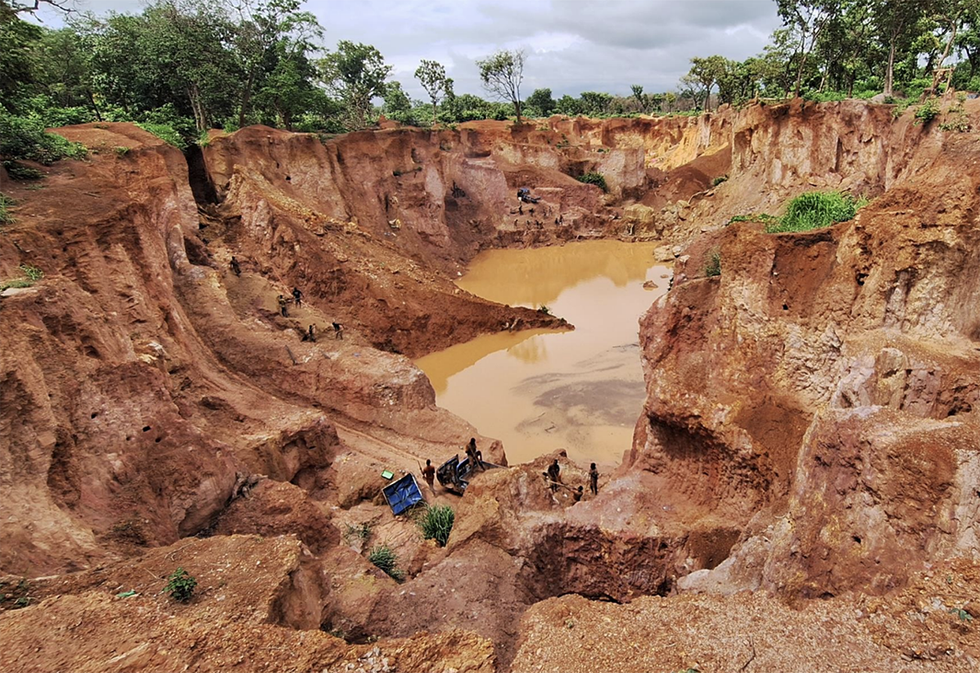
Boundiali Gold Project – BD Target 1 Artisanal Working
Aurum has entered into a Bid Implementation Agreement with Mako Gold for Aurum to acquire 100 percent of the issued shares in Mako. This proposed merger will allow both Aurum and Mako security holders to benefit from the combination of Aurum’s strong balance sheet and exceptional drilling efficiencies with AU$23 million in cash at the end of December 2024 to support work programs targeted at further resource definition across Aurum and Mako’s assets in northern Côte d'Ivoire. Aurum is currently in its final phase of compulsory acquisition of remaining Mako shares after it received over 90 percent acceptance of MKG shares in late January 2025.
Following its takeover of Mako Gold, Aurum holds 90 percent of the Napié Project located 30 km southeast of the city of Korhogo and covers a strike length of 30 km over a highly prospective land package of 224 sq km.
The merger is backed by a highly experienced board and management team with extensive gold experience from grassroots discovery, through to resource drill-out, feasibility studies, project finance, and production.
With a strong financial position backed by the recent $35.6 million private placement, Aurum is well-funded to execute exploration and development plans focused on delivering value for shareholders through resource growth and project advancement.
Company Highlights
- Aurum Resources is a precious metals company with exploration prospects in the same greenstone belt as the Syama (11.5 Moz), Sissingué (1.0 Moz), Tongon (5.0 Moz) and Kone Gold (4.5 Moz) deposits of West Africa.
- A total of 2.5Moz gold resource in Côte d'Ivoire, West Africa:
- Boundiali - 1.6Moz Gold Project
- Napié - 0.87Moz Gold Project
- Aurum operates its own drill rigs, allowing the company to significantly reduce its exploration costs relative to peers.
- Management has a track record of creating value for shareholders from exploration through to project development, mine construction and gold production.
- Strong leverage to increasing gold prices that will benefit from a declining interest rate environment and rising global geopolitical risk factors.
- Well-funded for more than 12 months and over 100,000 metres of diamond drilling programs and metallurgical study
- Aurum’s acquisition of 100 percent of Mako Gold’s issued shares (ASX:MKG) is in its final stage of compulsory acquisition of the remaining MKG shares after Aurum received over 90 percent acceptance in late January 2025.
Key Projects
Boundali Gold Project
The Boundiali gold project in Cote d’Ivoire is located within the Boundiali Greenstone Belt, which hosts Resolute’s Syama gold operation (11.5 Moz) and the Tabakoroni deposit (1 Moz) in Mali. Neighbouring assets also include Barrick’s Tongon mine (5 Moz) and Montage Gold’s Kone project (4.5 Moz).
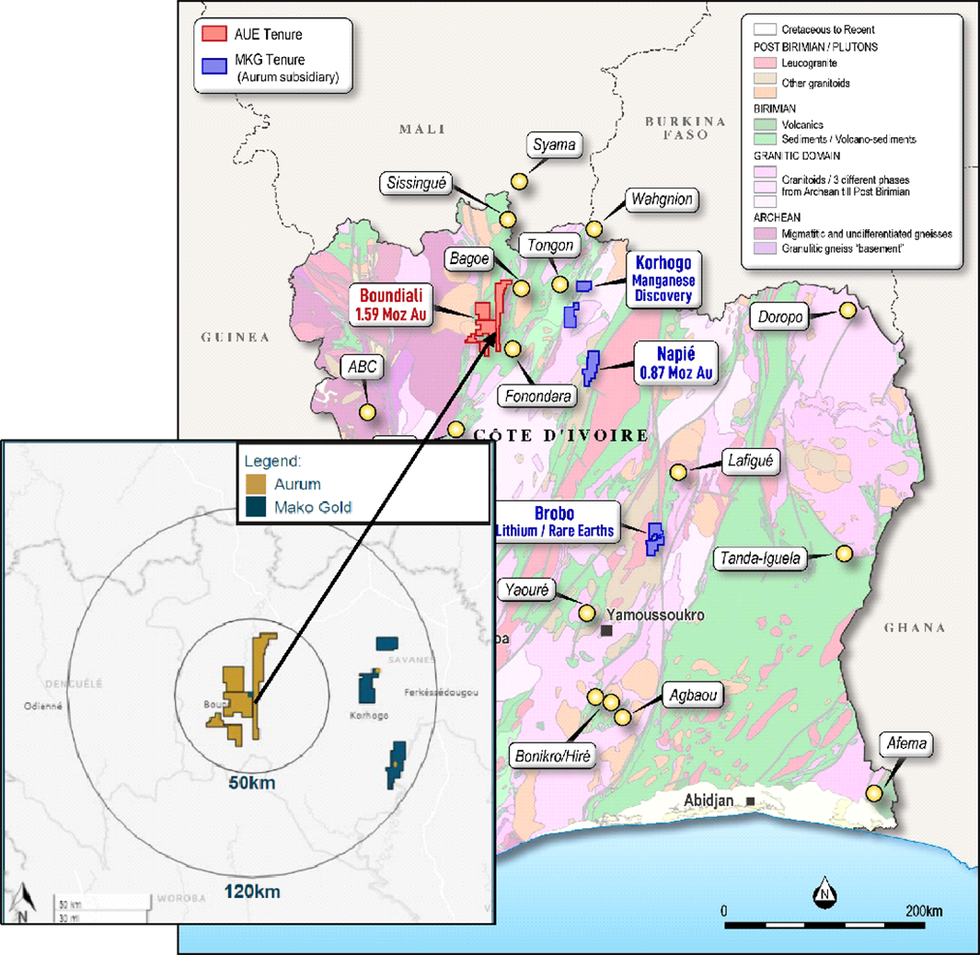
The Boundiali project area covers the underexplored southern extension of the Boundiali belt, where a highly deformed synclinal greenstone horizon traverses finer-grained basin sediments, and to the west, Tarkwaian clastic rocks lie in contact with a granitic margin. The project benefits from year-round road access and excellent infrastructure.
The first stage of drilling at Boundiali occurred from late October 2023 to end of November 2024 for both the BM and BD tenements (BM1 and BM2; BD1, BD2 and BD3 targets) and was designed to test below-gold-in-soil anomalies oriented along NE trending structures, define new gold prospects and define maiden JORC resources. With over 63,000m diamond holes drilled during this period, Maiden JORC gold resources estimate was delivered in late December 2024.
Drilling costs are estimated at US$45 per metre, as Aurum owns all of its eight drilling rigs and employs its operators, representing a significant value proposition relative to peers who use commercial drilling companies that charge upwards of $200 per meter. The company believes there is potential for multi-million ounce gold resources to be defined with hundreds thousands meters of drilling over years within the Boundiali Gold Project’s land holding areas.
The Boundiali gold project comprises four contiguous granted licenses: PR0808 (80 percent interest), PR0893 (80 percent and earning to 88 percent interest), PR414 (100 percent interest), and PR283 (earning to 70 percent interest). Historic exploration at PR0893 includes 93 AC drill holes and four RC holes. Airborne geophysical surveying, geological mapping and extensive soil sampling have also been performed at PR0893, while PR0808 has had 91 RC holes drilled for 6,229 metres along with geochemical analysis and modeling. Detailed geochemical sampling and drilling at PR414 revealed three strong gold anomalies and returned impressive high-grade results.
Following the renewal of its Boundali South (BST) exploration licence in September 2024, drilling at the Nyangboue deposit is planned for H1 2025 and H2 2025. Previous exploration at BST has returned impressive results, including 20 m at 10.45 g/t gold from 38 meters, and 30 m at 8.30 g/t gold from 39 m.

In May 2024, Aurum entered a strategic partnership agreement to earn up to a 70 percent interest in exploration tenement PR283, to be renamed Boundiali North (BN). Aurum, through subsidiary Plusor Global Pty Ltd, has partnered with Ivorian company Geb & Nut Resources Sarl and related party (GNRR) to explore and develop the Boundiali North (BN) tenement which covers 208.87sq km immediately north of Aurum’s BD tenement. Further to this agreement,
Aurum announced it has earned 80 percent project interest after completing more than 20,000 m of diamond core drilling.

Boundiali Project JORC Mineral Resource Estimate
Aurum has announced a maiden independent JORC mineral resource estimate of 1.59 Moz gold for its 1,037 sq. km. The Boundiali Gold Project comprises the BST, BDT1 & BDT2, BMT1 and BMT3 deposits. Drilling is ongoing on these deposits, and Aurum has identified other prospects at Boundiali which have yet to be drilled. Since October 2023, the company has completed an extensive 63,927-metre diamond drilling program. This aggressive exploration campaign has rapidly defined a significant gold resource of 50.9 Mt @ 1.0 g/t gold for 1.6 million ounces.
Growth Plans for the Boundali Project:
- Aggressive cost-effective exploration at Boundiali: Aurum is committed to a large-scale exploration program at Boundiali. This includes:
- 100,000 m diamond drilling: Up to eight diamond drill rigs will complete 100,000m of drilling at Boundiali in 2025. The program has multiple aims:
- Increase the size and confidence of current resources at BST, BD, and BM (40,000m).
- Advance known prospects (30,000m) for incorporation into two planned MRE updates in 2025.
- Target new prospects identified through soil anomalies and geological mapping to drive resource growth into 2026 (30,000m).
- Resource expansion: Drilling aims to expand the known resources at the BST, BD, and BM deposits.
- New discoveries: Exploration and scout drilling is planned on BD, BM and BST tenements to test new targets and create a pipeline of new discoveries to flow into resource growth.
- Boundiali resource updates: Aurum plans to deliver two MRE updates for Boundiali in 2025.
- Pre-Feasibility Study: Aurum is working towards completing an open pit PFS for the Boundiali Gold Project by the end of 2025. This will provide an evaluation of the project's economics and technical feasibility.
- 100,000 m diamond drilling: Up to eight diamond drill rigs will complete 100,000m of drilling at Boundiali in 2025. The program has multiple aims:
Napié Gold Project
Aurum holds a 90 percent interest in the Napié Project in north-central Côte d’Ivoire, acquired through its takeover of Mako Gold. Located approximately 30 km southeast of Korhogo, the project covers a 224 sq km land package with a 30 km strike length along the highly prospective Napié Shear Zone.
As of June 2022, Napié hosts a JORC 2012 Mineral Resource Estimate of 868,000 ounces of gold (22.5 Mt at 1.20 g/t Au), based on the Tchaga and Gogbala deposits—two of four known prospects along the shear. To date, only 13% of the Napié Shear has been explored, leaving substantial potential for further discoveries.

Napié Project – Previous results with detailed mapping area on Komboro Prospect shown in black rectangle
Project Highlights:
- Gold Resource: Shallow open pit 0.87Moz JORC Resource at 1.20g/t Au, with mineralisation open along strike and at depth. Maximum resource depth between 160 m – 195m across the two deposits
- Exploration Upside: Less than 13 percent of the 30 km Napié Shear has been explored, offering significant potential for resource growth.
- Drilling Commenced in June 2025: 30,000 m of diamond drilling has commenced to expand the project's resource.
- Preliminary Recovery Test Work: Returned more than 94 percent average gold recoveries.
- Resource Growth Target: First MRE update planned end of 2025, to significantly expand the resource base.
- Infrastructure: Excellent access to hydroelectricity, roads, and water, supporting future development.
Management Team
Troy Flannery – Non-Executive Chairman
Troy Flannery has more than 25 years’ experience in the mining industry, including nine years in corporate and 17 years in senior mining engineering and project development roles. He has a degree in mining engineering, masters in finance, and first class mine managers certificate of competency. Flannery has performed non-executive director roles with numerous ASX listed companies and was the CEO of Abra Mining until October 2021. He has worked at numerous mining companies, mining consultancy and contractors, including BHP, Newcrest, Xstrata, St Barbara Mines and AMC Consultants.
Dr. Caigen Wang – Managing Director
Dr. Caigen Wang founded Tietto Minerals (ASX:TIE), where he led the company as managing director for 13 years through private exploration, ASX listing, gold resource definition, project study and mine building to become one of Africa’s newest gold producers at its Abujar gold mine in Côte d’Ivoire. He holds a bachelor, masters and PhD in mining engineering. He is a fellow of AusIMM and a chartered professional engineer of Institution of Engineer, Australia. Wang has 13 years of mining academic experience in China University of Mining and Technology, Western Australia School of Mine and University of Alberta, and over 20 years of practical experience in mining engineering and mineral exploration in Australia, China and Africa. Other professional experience includes senior technical and management roles in mining houses, including St. Barbara, Sons of Gwalia, BHP Billiton, China Goldmines PLC and others.
Mark Strizek – Executive Director
Mark Strizek has nearly 30 years’ experience in the resource industry, having worked as a geologist on various gold, base metal and technology metal projects. He brings invaluable geological, technical and development expertise to Aurum, most recently as an executive director at Tietto Minerals’, which progressed from an IPO to gold production at the Abujar gold project in West Africa. Strizek has worked as an executive with management and board responsibilities in exploration, feasibility, finance and development-ready assets across Australia, West Africa, Asia and Europe.
Keep reading...Show less
01 July
Equity Metals: Advancing High-grade, District-scale Silver and Gold Assets in British Columbia
Equity Metals (TSXV:EQTY,OTCQB:EQMEF,FSE: EGSD) is rapidly advancing exploration at its 100 percent-owned Silver Queen Project in British Columbia, aiming to expand resources and further de-risk one of the province’s most promising high-grade polymetallic deposits. Situated in the prolific Skeena Arch—home to the historic Equity Silver and Huckleberry mines—Silver Queen hosts an NI 43-101 compliant resource of 62.8 million ounces silver equivalent (indicated) and 22.5 million ounces silver equivalent (inferred). Ongoing drilling in 2024 continues to extend known zones while uncovering new areas of mineralization.
The company is also advancing its newly acquired Arlington Project, a district-scale, never-before-drilled gold-copper-silver asset located in southern BC’s Greenwood Mining Division. With geological similarities to historic producers such as Phoenix and Buckhorn, Arlington is currently undergoing an aggressive 3,000-meter drill program, targeting high-grade, gold-enriched polymetallic mineralization.
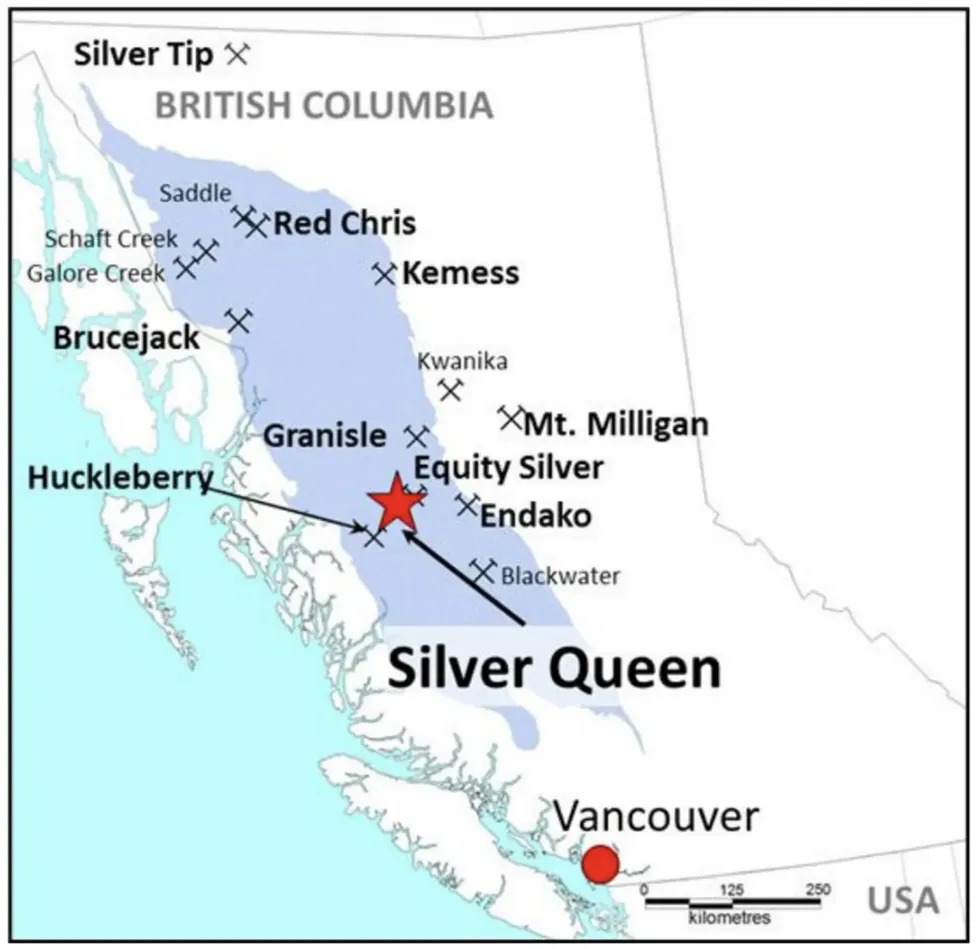
The Silver Queen Project is Equity Metals’ 100%-owned flagship asset, located in the heart of British Columbia’s prolific Skeena Arch, approximately 35 kilometers south of Houston. Covering 18,871 hectares, the property comprises 17 crown-granted titles and 46 mineral tenure claims within the Omineca Mining Division. Strategically positioned among past-producing and active mines, including the Equity Silver Mine, Berg, Endako, and Mt. Milligan, the project is well supported by established infrastructure, with convenient access to roads, power, and rail.
Company Highlights
- Flagship High-grade Project – Silver Queen: Over 85 million silver-equivalent ounces defined in the heart of BC's Skeena Arch mineral belt, surrounded by Tier 1 infrastructure and historical producers.
- New Gold Discovery Potential – Arlington project: A district-scale, early-stage gold-copper-silver system with analogues to major past-producing skarn and vein-hosted mines in the region.
- Fully Funded for 2025: 9,000 meters of combined drilling is underway across both Silver Queen and Arlington with assay results expected to drive news flow through Q3 and Q4 2025.
- Experienced Management and Technical Team: Track record of discovery and mine development across North America, including the Penasquito and Eskay Creek mines and the Wind Mountain project.
- Exposure to Critical and Precious Metals: Balanced portfolio spanning silver, gold, copper and diamonds with optionality in battery materials (silica) and critical minerals.
This Equity Metals profile is part of a paid investor education campaign.*
Click here to connect with Equity Metals (TSXV:EQTY) to receive an Investor Presentation
Keep reading...Show less
Latest News

Sign up to get your FREE
Brightstar Resources Investor Kit
and hear about exciting investment opportunities.
- Corporate info
- Insights
- Growth strategies
- Upcoming projects
GET YOUR FREE INVESTOR KIT
Latest Press Releases
Related News
TOP STOCKS
American Battery4.030.24
Aion Therapeutic0.10-0.01
Cybin Corp2.140.00

